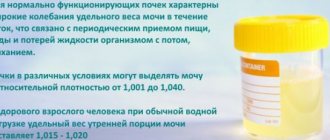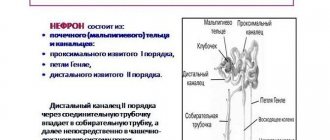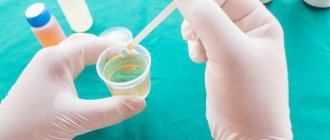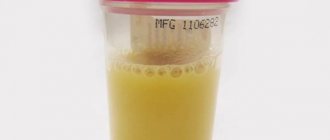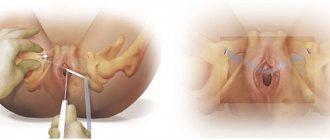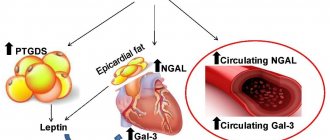Bilirubin is not detected in the urine of a healthy person. The bilirubin component is excreted in bile through the intestines. Normally, some bile pigment may be excreted in urine, but traces of bilirubin are small and undetectable by standard laboratory testing. Detection of this element in urine indicates a disease or indicates improper collection of material.
How bile pigment can get into urine
To understand how bilirubin gets into urine, you should consider where this substance comes from and how it is disposed of:
- After the death of an expired red blood cell, hemoglobin protein remains. Under the action of blood enzymes, hemoglobin breaks down and unbound bilirubin is released. This is a toxic compound for the body. Dissolves only in fats.
- Bilirubin is bound by carrier proteins and transported to the liver.
- In hepatocytes (liver cells), the pigment reacts with glucoronic acid. After this, the substance loses its toxicity and becomes part of the bile that accumulates in the gallbladder. This is direct bilirubin.
- During digestion, bile is released into the duodenum, where the pigment is transformed into stercobilinogen under the influence of intestinal juices. The substance is excreted in the feces.
A small part of the bound pigment is absorbed through the intestinal wall into the bloodstream and delivered to the kidneys. When urine is formed, urobilinogen is produced, which gives the straw or yellow color of urine. A small amount of bilirubin may enter the urine from the blood during filtration in the kidney tubules.
Standard urine tests may show traces of bilirubin. The level of direct or indirect bilirubin increases when the liver can no longer cope with the work of binding the component.
In what cases is a urine test for bilirubin prescribed?
A general urine test can detect the bilirubin component. The test result is the reason for conducting specific studies, determining the amount of indirect and direct bilirubin in the urine and blood.
In addition to identifying elevated bilirubin levels, the reason for research is suspicion of the following diseases and conditions:
- hemolytic anemia,
- atrophic processes in the liver,
- poisoning with poisons that cause hemolysis (disintegration) of red blood cells,
- hepatitis,
- neoplasms in the pancreas,
- abnormalities in the functioning of the spleen (red blood cells are utilized in this organ),
- cholelithiasis,
- liver injuries,
- bile stagnation,
- obstruction of the bile ducts,
- metastasis to the liver or spleen,
- metabolic disorder (acquired or congenital),
- obstructive jaundice.
An increase in pigment in the urine is caused either by increased destruction of heme protein or by a decrease in the functions of hepatocytes.
In what diseases is bilirubin excreted in the urine?
Considering the mechanism of penetration of various forms of pigment into urine, we can say that it is utilized by the kidneys only when excretion through the intestines is difficult or impossible. The reason for this state of affairs may be damage to liver cells, accompanied by a violation of the formation and movement of bile into the bladder, namely:
- parasitic, viral, bacterial, toxic hepatitis;
- autoimmune liver damage;
- hereditary diseases;
- cirrhosis;
- Dubin-Johnson and Rotor syndromes.
Diseases of the biliary system, in which the outflow of bile is disrupted, can provoke increased absorption of direct bilirubin:
- inflammation of the ducts (cholangitis);
- cicatricial changes in the tracts;
- GSD (cholelithiasis);
- tumors and cysts of the head of the pancreas;
- duodenal diverticula;
- hepatic artery aneurysm.
The appearance of bilirubin in the urine of pregnant women can be caused by congestion in the gallbladder, as a result of increased intra-abdominal pressure under the influence of the growing fetus. Such disorders are more often observed in the last trimester and are called cholestatic hepatitis. In children, the pigment can exit through the kidneys against the background of difficult outflow of bile due to congenital anomalies in the development of the bladder and ducts (kinks and torsions).
How to properly prepare for research
Minor bilirubinuria may indicate an incipient disease or appear due to improper preparation for the delivery of biomaterial. To avoid a false positive result, you must:
- before taking the test, do not eat food that changes the color of urine (beets, citrus fruits, carrots) for 1-2 days,
- stop eating foods with diuretic properties (watermelons) one day before,
- Before collecting urine, do not eat, smoke or drink liquids for 10-12 hours, and do not take physical procedures.
If you constantly take medications, then you need to stop taking the following medications for a day:
- diuretics,
- sulfonamides,
- barbiturates,
- oral contraceptives,
- steroids.
If it is not possible to stop taking the medications, then you need to inform the laboratory assistant. A note on the medication taken on the referral form will prevent false interpretation of the results.
A woman should not donate biomaterial during menstruation. Blood entering the urine and partial breakdown of red blood cells with subsequent release of bilirubin will lead to a false positive result.
To avoid incorrect testing data, urine should be collected 1-2 days after the end of your period.
Self-determination of bilirubin in urine
You can purchase test strips from the pharmacy chain and do a urine test yourself. Complex tests are sold that determine almost all urine parameters, and simple testers that detect only bilirubin and urobilinogen.
Test strips are sold in tubes with a test scale painted on the surface of the jar. It’s easy to do your own research:
- open the package,
- collect fresh urine (biomaterial cannot be stored for more than 2 hours),
- take out the tester without touching the place where the indicator is applied,
- dip the tip with the applied reagents into the liquid for 3-5 seconds,
- tap the strip on the edge of the jar to remove excess urine,
- place on a horizontal surface.
You will have to wait for the result from 30 seconds to 3 minutes (the time depends on the nature of the reagent and is indicated in the annotation). After the chemical reaction is completed and the indicator changes color, you need to evaluate the result using the scale drawn on the tester container.
The test is carried out only on warm urine. If the urine has been cooled, the cold will slow down the chemical reactions and the result for bilirubin will be incorrect. It is better to urinate immediately before rapid testing.
Norm of bilirubin in urine in men, women and children
First, you should familiarize yourself with how bilirubin is indicated in a urine test. On some forms the Russian names of the components of urine are written, and sometimes the Latin abbreviation is used: bilirubin will be designated as BIL.
If the permissible norm in an adult’s blood is up to 17 mmol/l, then in the urine these indicators will be much lower.
The norm of bilirubin pigment µmol/l is:
- urobilinogen – 0-35,
- direct bilirubin – 0-8.5.
The indicator does not increase in women during pregnancy.
In children, there should be no direct bilirubin in the urine, and the amount of urobilinogen in daily urine should not exceed 5-10 mg/l.
Negative urine bilirubin indicates that the liver is healthy and the kidneys are fully filtering urine. But at the same time, the amount of urobilinogen should not exceed normal values.
Causes of elevated bilirubin
Most often, bilirubin in the urine is increased due to impaired heme metabolism in the liver or obstructed release of bile into the intestines. This causes changes in urine and feces, as well as a icteric coloration of the skin (this symptomatology is commonly called “jaundice”). Based on this, suprahepatic, hepatic and subhepatic jaundice are distinguished. Their clinical manifestations are very similar, but the mechanism of development is different.
Prehepatic jaundice
This type of jaundice is also called “hemolytic.” There is no change in the number of red blood cells, but massive hemolysis (destruction) occurs due to an infectious disease or congenital defect. This phenomenon is caused by pathologies such as hemolytic anemia, malaria, drug-induced liver damage, leukemia and others. Even in a urine test, you can see an increase in the level of bile pigments.
The only prehepatic jaundice that is considered normal is neonatal jaundice. The child begins to turn yellow on the 3rd-4th day of life.
At this time, hemolysis of fetal (congenital) hemoglobin occurs and its replacement with normal. This condition disappears completely after 3-4 weeks and does not require treatment, with the exception of transition to massive hemolysis with brain damage. Here, differentiation is carried out with hemolytic disease of newborns (for example, against the background of Rh conflict).
Hepatic jaundice
Hepatic, or parenchymal, jaundice develops in adults. Causes:
- liver cancer;
- severe hepatitis and cirrhosis;
- liver failure.
It manifests itself as yellowing of the skin and sclera, heavy bruising and bleeding. In advanced cases, patients exhibit ascites (fluid retention in the abdomen) and hepatic encephalopathy due to toxic effects on brain cells. The treatment is long-term. Often only a liver transplant helps.
Subhepatic jaundice
The most common and safest type of jaundice. The formation and exchange of bilirubin is not impaired, but its outflow along with bile is difficult. The reason for this is stones in the gallbladder or ducts. The formation of calculi (stones) is often facilitated by abnormalities in the development of the organ: curvature of the ducts, kinks. Bilirubin cannot enter the intestines, it stagnates in the bile ducts and ducts, and the pigments are absorbed into the blood. The level of bilirubin in human urine increases sharply, and the liquid becomes dark brown in color. Feces, on the contrary, do not receive their pigment at all and become discolored.
Other manifestations of bilirubinuria
Slightly increased bilirubin in the urine may not cause signs of deterioration in health. Only the color of urine changes - due to increased secretion of the bilirubin component.
Severe bilirubinuria, when the urine has a rich dark color, is accompanied by characteristic signs:
- yellowing of the sclera and mucous membranes,
- yellowness of the skin,
- dry and itchy skin,
- nausea,
- bitter taste on the tongue
- belching air,
- discomfort under the ribs on the right,
- increased fatigue,
- lightening of stool (up to complete discoloration),
- skin rashes,
- hepatic colic.
The appearance of these signs indicates that bilirubin, due to pathological abnormalities, cannot be excreted through the intestines and enters the urine in large quantities. The resulting condition requires medical examination.
conclusions
- A condition in which bilirubin is excreted in the urine is called bilirubinuria.
- In a healthy person (urine) there should be no pigment, or its concentration can be up to 8.5 µmol/l in adults.
- Excretion of the substance through the kidneys means diseases of the hepatobiliary tract. This may be damage to the liver parenchyma or bile ducts.
- If your urine test shows abnormalities, you need to go to the doctor. When the causes of disorders are unknown, self-medication is unacceptable.
- As a rule, the appearance of bilirubin in the urine is accompanied by high levels of the substance in the blood. The condition is typical for hepatitis, cirrhosis, fatty liver hepatosis and other serious diseases. Read in detail about the causes of increased bilirubin in the blood, methods of diagnosis and treatment here.
Reasons for increased bilirubin
Bilirubinuria does not always indicate pathological processes. A moderate increase in bile pigment can be triggered by external factors or natural causes.
Physiological factors
Detection of traces of bilirubin in a newborn in the first week of life is considered normal. This is due to the breakdown of red blood cells that have passed from the mother’s blood to the baby before birth. Gradually, the baby’s hematopoietic system begins to work, and the release of pigment in the urine stops. Physiological jaundice is safe for health.
In adults and in children who have emerged from the neonatal period, physiological bilirubinuria does not develop. Detection of bilirubin in urine indicates a problem.
Diseases
In adults, an increase in bile pigment in the urine is often associated with liver pathologies. The reason may be:
- viral hepatitis,
- cirrhosis,
- liver failure,
- fatty hepatosis,
- liver tumors,
- infectious inflammations causing damage to hepatocytes (mononucleosis, brucellosis, leptospirosis),
- chronic intoxication with drugs or alcohol,
- obstruction of the bile ducts due to spasm or stone blockage.
In addition to abnormal liver function, bilirubinuria is caused by:
- hemolytic anemia,
- blood transfusion (transfusion) of incompatible blood,
- chemotherapy in the treatment of malignant neoplasms,
- large blood loss,
- severe infections (malaria, typhus),
- sepsis,
- severe poisoning,
- long-term use of certain medications (NSAIDs, hormones).
High bilirubin in the urine of a child is possible with increased blood glucose. If childhood bilirubinuria is detected, then the urine is additionally examined for sugar and ketone bodies. This will determine a violation of glucose metabolism.
Pregnancy
In later stages, the uterus sometimes compresses the hepatic and gall bladder ducts, complicating the outflow of bile secretions. This provokes stagnation of bile and can lead to inflammation in the liver and the formation of stones.
During pregnancy, the body is more vulnerable; the expectant mother may develop toxic damage to liver cells when taking medications, hepatitis or gallstone disease. Diseases can appear at any time.
Bilirubinuria in pregnant women requires special attention. Timely detection of abnormalities in liver function will allow a woman to maintain health and avoid complications during pregnancy.
General urine analysis
Chervyakova Anna Alekseevna laboratory assistant
General clinical urine examination is one of the most frequently prescribed laboratory tests. Based on the results of this analysis, one can judge the state of the organs of the urinary system and the effectiveness of the urinary (it is performed by the kidneys) and urinary (the ureters, bladder and urethra are responsible for it) functions of the body, indirectly about the state of other body systems.
A very important stage of the study is the correct collection of urine for analysis. It is important to remember that no more than 2 hours should pass from the moment of urine collection to the end of the laboratory test . Otherwise, you risk getting false results, since when stored for more than 2 hours, the properties of urine change dramatically.
General clinical urine analysis is carried out according to the following parameters:
- physical properties
- Chemical properties
- microscopic examination.
Study of the physical properties of urine The physical properties of urine are studied by organoleptic methods, that is, as a result of assessing the appearance of urine using our senses, namely vision and smell. Every attentive owner can, and even should, independently monitor the slightest changes in the process of urination, the quantity, color, transparency, and smell of his pet’s urine, so that in time, sometimes even before the general condition worsens, seek help from a doctor. As you yourself understand, this assessment is purely subjective and only indirectly indicates the problem. Therefore, if you notice that your animal’s urine has changed or the process of urination has been disrupted, you should definitely, without delay, consult a doctor to find out the reasons and get tested in a laboratory for professional research. The study of the chemical properties of urine and microscopic examination of its sediment provides the doctor with objective results; it is carried out only in a laboratory, using laboratory methods and equipment.
Study of the chemical properties of urine
Relative density (specific gravity) measures the amount of dissolved particles in the urine and has varying values in healthy cats and dogs, with normal values ranging from 1.010 to 1.025 on average. It is very important to obtain data on the relative density of urine before starting treatment, especially before infusion therapy and the prescription of diuretics. A decrease in density to 1.007 and below and an increase in density over 1.030 indicate that the concentration and diluting capacity of the kidneys is only partially preserved.
Urine pH is an indicator of the concentration of free hydrogen ions. Healthy dogs and cats can have a pH of 5.5-7.5. The reasons for the change may be heavy intake of meat, vomiting, diarrhea, chronic urinary tract infections, cystitis, pyelitis and other reasons.
Protein in the urine - proteinuria accompanies almost any kidney pathology. This indicator must be interpreted in conjunction with relative density. Normally, in healthy animals, protein does not increase more than 0.3 g/l. To more accurately determine the severity of protein losses, more quantitative methods are required - daily testing of protein in the urine, the ratio of protein to creatinine in the urine.
glucose in the urine (glucosuria) of healthy animals. The appearance of glucose in the urine may indicate the most common disease in animals, diabetes mellitus. However, you should always measure your blood sugar levels. Glucose can appear in animals under stress, especially cats. In addition to diseases of the pancreas, glycosuria appears in acute renal failure, glomerulonephritis, hyperthyroidism, and certain medications.
Ketones are not normally found in urine (ketonuria). Ketonuria appears when there is a violation of carbohydrate, fat or protein metabolism. Exhaustion, fasting and diabetes are among the most common causes of ketones in the urine. Ketonuria can also accompany acute pancreatitis and extensive mechanical injuries.
Bilirubin in the urine (bilirubinuria). Dogs (especially males) may have small amounts of bilirubinuria if the relative gravity of the urine is equal to or greater than 1.030. Cats do not normally have bilirubinuria. The most common causes of severe hyperbilirubinuria in dogs and cats are liver disease, bile duct obstruction, and hemolytic disorders. Mild bilirubinuria may result from prolonged fasting (anorexia).
Urobilinogen in the urine (urobilinogenuria). The physiological concentration in urine is 17 µmol/l. This test cannot determine the complete absence of urobilinogen. Increased excretion of urobilinogen in the urine occurs with increased intravascular breakdown of red blood cells (pyroplasmosis, sepsis, disseminated intravascular coagulation syndrome) and with chronic liver diseases.
Nitrites in the urine (nitrituria). Urine from healthy animals gives a negative test result. The detection of nitrites in the urine indicates infection of the urinary system. But it should be remembered that in this test there is a possibility of obtaining a false negative result. Therefore, it is impossible to draw conclusions about the presence or absence of kidney and urinary tract infections solely on the basis of this study.
Microscopic examination Some diseases of the kidneys and urinary tract are often asymptomatic. Therefore, urine sediment is examined under a microscope.
Epithelium . In urine sediment there are 3 types of epithelium: squamous transitional and renal. In healthy animals, epithelium is not present in the urine. But small amounts of squamous epithelium are very common in urine samples received by the laboratory, and this, as a rule, is not a sign of pathology. It enters the urine from the mucous membrane of the external genitalia at the time of urination. But the appearance of transitional epithelium, and especially renal epithelium, in the urine indicates serious damage to the kidneys, ureters, and bladder.
Leukocytes . Normal values should not exceed 0-3 leukocytes per field of view. This abnormality indicates inflammation and infection of the urinary tract. Other common causes of large numbers of white blood cells in the urine include stones and neoplasia. Also, a large number of leukocytes can enter the urine from preputial or vaginal secretions; to exclude these factors, it is better to take urine by cystocentesis, or try to collect a medium portion of urine. Leukocyturia is often accompanied by bacteriuria.
Red blood cells . The presence of red blood cells (hematuria, or blood in the urine) or their derivative hemoglobin (hemoglobinuria) is first determined by a test strip. The blood test must be negative. Regardless of the test strip readings, a microscopic examination of the urine sediment is performed for the presence of red blood cells. Normal values range from 0 to 5 red blood cells per field of view. Particular attention should be paid to the moment of urination when bleeding appears. Blood in the urine, regardless of urination or most strongly at first, indicates damage to the urethra, prostate or foreskin in male dogs or the uterus (vagina) in females. Blood at the end of urination indicates damage to the bladder. If blood is present throughout urination, then this can be caused by bleeding in any part.
Cylinders . These are cylindrical sediment elements, consisting of protein and cells with various inclusions, representing casts of the renal tubules. Normally, healthy animals may contain 0-2 hyaline cylinders in the field of view. The presence of casts confirms kidney disease. The type of casts provides some information about the pathological process; the number does not correlate with the reversibility or irreversibility of the underlying disease. Often, when casts appear in the urine sediment, proteinuria is also recorded and renal epithelium is detected.
Slime . A small amount of mucus may be present in the urine of healthy animals. This is a normal secretion of the mucous glands of the urinary tract. When the content of this secretion is very high, a large, viscous, mucous sediment is formed in the urine. Such changes are characteristic of cystitis.
Crystals (salts) . Microscopic recognition of urinary crystals is an imperfect technique because their appearance varies through numerous factors. Many crystals may occur normally in small quantities. For example, calcium oxalates, calcium phosphates, ammonium urates (especially in Dalmatians and English bulldogs), bilirubin crystals in healthy dogs with concentrated urine. A large number of crystals often makes one think about the presence of urolithiasis (stones). Animals with crystalluria do not always form stones (uroliths), and detected crystalluria is not always an indication for treatment.
Bacteria . In a healthy animal, the urine in the kidneys and bladder is sterile. Therefore, urine obtained by puncture of the bladder (cystocentesis) should normally not contain bacteria. Bacteria in urine excreted may be the result of a urinary tract infection or contamination of the distal urethra and genitals by normal flora. Very often there is a false increase in the number of bacteria in the urine due to improper collection in a non-sterile container and storage of urine at room temperature. The presence of bacteria in the urine, when taken correctly, allows the diagnosis of a urinary tract infection. In this case, quantitative bacteriological urine culture is recommended to determine the significance of bacteriuria and determine the sensitivity of detected bacteria to antibacterial drugs.
